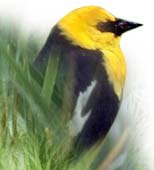Wetlands benefits include the cleansing of water as it flows through natural
systems, preventing catastrophic floods by absorbing and holding water,
reducing erosion along moving waterways by supporting vegetation that
withstands erosion, and recharging aquifers from water stores. Other benefits
include habitat for livestock and wildlife, and recreational and educational
opportunities. Wildlife habitat quality is usually very high in wetlands.
Extremely productive and diverse, wetlands feed insects, fish, birds, mammals,
and amphibians. In Colorado, about one-fourth of all vertebrate species depend
on wetlands in some season or period of their lives, and 40% of the rare plant
communities in the state are found in wetland systems (Colorado Natural
Heritage Program). During summer, wetlands provide breeding habitat for geese,
pelicans, cormorants, 16 species of ducks, 4 grebes, 8 types of wading birds, 3
raptors, 3 rails, 4 gulls and terns, 9 shorebirds, and 32 species of songbirds,
a total of 82 bird species in Colorado.
Threats to wetlands are as diverse as the wetlands themselves. Destruction of
wetland habitat outright is perhaps the most obvious. Development pressure, as
evidenced along the Front Range, will continue to threaten wetland systems, if
not directly, indirectly by altering topography and hydrology. Protection of
wetland areas by conservation easements is a popular method for decreasing
threats to wetlands by development. Changes in water levels at a site can
immediately result in changes in vegetation and wildlife use. On mudflats and
shallow playas, many shorebirds rely upon water less than several inches deep
for foraging; deeper or shallower water can completely eradicate their foraging
habitat. Likewise, many marsh nesters place their nests in emergent vegetation,
several inches above the water, and fluctuations of water greater than about 6
inches during the breeding season can cause failure of their nests. The
underlying causes for changes in water levels may or may not be obvious, and
they may be natural or human-induced. Water levels may be affected by a
lowering of the water table either due to reduced natural supply from snowmelt
or by pumping wells for agricultural or domestic purposes; by rivers or streams
changing channels; by diversion for irrigation, consumption, or recreational
use; or by decreases in natural runoff. Sometimes water levels are affected by
specific construction (of dikes, dams, ditches) or excavation. Some actions may
have unanticipated results, such as when a clay layer is punctured when
excavating to increase the holding potential of a pond, resulting in a
reduction of its water-holding potential rather than an increase. Changes in
water quality may drastically alter the composition of fauna associated with
the wetlands. Toxicity due to excessive nutrient levels, pesticides, and
herbicides as well as sediment loads may affect invertebrates, fish, and
amphibians, which in turn affect the wetland-dependent bird species: wading
birds, diving ducks, kingfishers, and rapto rs. The higher trophic level
predators of fish and mammals and other birds are particularly vulnerable to
increased toxicity due to the concentration of toxins as they proceed up the
food chain. Recreational activity may threaten wetland habitat for some of the
more shy bird species. Great Blue Herons, White Pelicans, other
colonially-nesting birds, and Bald Eagles avoid areas with high levels of
disturbance, such as reservoirs with heavy boat traffic. In addition, waves
caused by motorized boat usage can cause the failure of marsh nests placed in
emergent vegetation just above the water. Grazing by domestic livestock or wild
ungulates may impact wetland areas, as particular vegetation types may be
selectively grazed (e.g., young willow shoots), or vegetation structure may be
changed by a combination of grazing and trampling (e.g., altering grass or
sedge density and height). Thus, the species composition of vegetation as well
as its structure may be altered by grazing; nest and foraging sites are, in
turn, affected by those vegetative changes. High concentrations of livestock
near wetlands may also affect the number of Brown-headed Cowbirds present;
these brood parasites reduce the reproductive success of many other songbirds
when they lay their eggs in other birds' nests. Non-native plant species, often
referred to as "weeds" or "exotics," can threaten wetland systems by invading
and creating monocultures of habitat that is not native to the area. These
plants can disrupt the normal hydrologic regime, alter the composition of
insect fauna (because insects are tightly tied to the plants), and displace
native plants that provide key food or nesting resources. Examples in Colorado
include tamarisk, Russian olive trees, Canada thistle, whitetop, and purple
loosestrife. Weed control programs are rapidly gaining support as community
members identify problems associated with weeds and target areas for
restoration of native vegetation.
Other Wetland Conservation groups & Programs...
-
Bureau of Reclamation - Wetland Development Program
-
Colorado Division of Wildlife - Colorado Duck Stamp, Colorado Wetlands
Initiative
-
Colorado Natural Heritage Program
-
Ducks Unlimited - Matching Aid to Restore States Habitat Program
-
Environmental Protection Agency - Wetland Protection Development Grants Program
-
Natural Resource Conservation Service - Wetlands Reserve Program, Wildlife
Habitat Incentives Program
-
North American Colonial Waterbird Society
-
North American Waterfowl Management Plan
-
North American Wetland Conservation Act
-
The Nature Conservancy - Freshwater Initiative
-
United States Fish and Wildlife Service - Partners for Fish and Wildlife
-
United States Shorebird Conservation Plan



